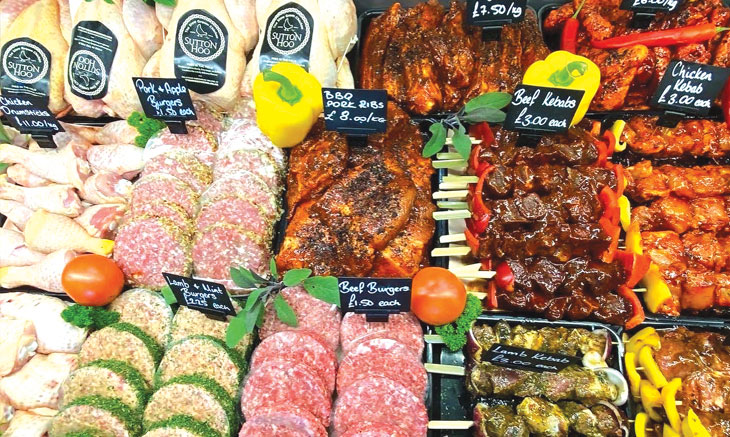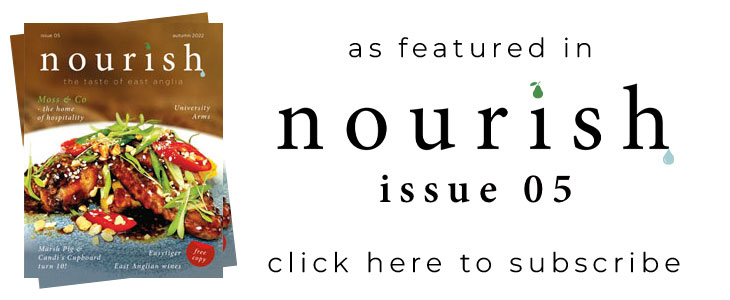Rebecca Mayhew from Old Hall Farm in Woodton has put together some ideas to help you shop for the sake of the planet, your health, and your wallet.

While the blame for climate change seems to fall on the shoulders of those who have grown your food for generations most of the time, it’s only fair that as farmers change their methods of farming to sequester carbon and help to reduce climate change through regenerative farming methods, that we as consumers should do our bit to help as well.
As we head into what may well be a hard few months with the cost of everything seeming to escalate from one minute to the next, here are some ideas to try to make our lives easier.
Our diets contribute towards 25% of our carbon footprint. Therefore, how we shop, cook, and eat can
have a positive impact towards reducing the effects of climate change. It is, of course, worth noting that the remaining 75% of our carbon footprint comes from other areas of our lives. We have to eat, regardless of we you do the rest of the time, but if we start with good habits in one area of our lives, it’s easier to start addressing other areas once we get in the right mindset.

food waste
EAT EVERYTHING YOU BUY – save food and money.
You’d be surprised how often this isn’t the case. 40% of all food produced is wasted, not an insignificant amount. Some of this is the fault of the supermarkets who only like selling straight cucumbers and curved bananas. However, a lot of this food also gets wasted in the home environment. Packaging comes into this area – reduce plastic waste by buying fruit and vegetables loose.
Planning your weekly shop is a great way to help. If you find that you have leftover food from the previous week, find a way to incorporate it into your meal planning for the coming week. Slightly soft veggies won’t do you any harm; use them in a casserole/stir fry and you’ll probably never notice the difference.
Best before dates are a guide. Always use your nose before throwing something away. Use by dates are a little more stringent, but I’d never worry about using something on its use by date. Again, use your nose before discarding.
eat seasonally
Yes, eating seasonally is cool, but to be frank, we should never have done anything differently. Food
grown locally and in season doesn’t have to be flown in and refrigerated for long periods of time. Neither does it need to be grown in a fossil fuel heated environment. Buying in season also means you benefit from price reductions due to gluts in the amount grown. Keep your eye out for reduced prices when you’re shopping – you can freeze much of what you buy so you can use it out of season. For instance, blanching, then freezing veg is great for extending the season in your own home.
Food labels are unlikely to include information about transport, but they do state the country of origin. If it is far away, ask yourself if the produce is robust enough to have travelled by boat. If not, it may have been flown in. Out-of-season asparagus, green beans, mangetout, shelled peas, baby corn, and berries are among the foods sometimes air-freighted – eating strawberries in December isn’t natural, so don’t do it!
Buying locally grown produce also means that you’re supporting a local business, therefore helping to keep up local employment rates. This is incredibly important – not only for your local area, but if we don’t wish all our food to be imported from other countries where we have no idea how it will be grown and what the ecological impact of growing that food is, it’s essential.

choose the RIGHT meat
Eating for the planet doesn’t mean that you have to give up meat. Ask questions about where the meat comes from and how it has been produced. If animals are fed crops that humans could eat directly, this is less efficient than eating the plants ourselves. That being said, no one wants to live on bread alone, so choose beef and lamb that have been purely PASTURE fed and finished on grass, not grain and soya.
Imported beef, especially from somewhere like Brazil where cattle ranching is the key driver of deforestation both for keeping cattle and for producing soya to feed them, can have around three times the carbon footprint of British beef. Where meat is produced and what practices are used to produce it makes a big difference to its carbon cost. Most beef sold in the UK is farmed here – check the packaging – and grass-feeding cattle is common in Britain, although it is often supplemented in winter. Much British grazing land is also not suitable for growing crops and is therefore perfect for growing cattle and sheep for meat, milk, and fibre.
Don’t forget the ecosystem services provided by livestock – when managed correctly in a regenerative farming system, these animals sequester carbon and increase biodiversity in the soil and their local environment. Insect populations would be devastated without livestock. If the insect population is drastically reduced, the bird population would be affected, and pollination of our crops would be severely impacted.
Cutting out meat ostensibly to save the planet is a misnomer. With pork and poultry, try to purchase meat and eggs that have been produced without the use of soya, which has a huge carbon footprint in its own right. Pigs and chickens do need to eat some grains due to how their digestive systems work, whereas cattle and sheep do not. If you can, buy direct and ask the farmer what their animals have been eating.
If you like to eat a lot of chicken, try buying a whole chicken and cutting it up yourself – the internet has plenty of videos to help! Make sure that you use the whole bird and use the leftover carcass to make soup/stock; there’s tons of flavour to be had and you can use leftover vegetables to create a tasty and healthy meal.
It’s also important to remember that we don’t have to eat meat every day – eat better meat and add pulses and legumes, grown in the UK, to your meals to ensure you have a good amount of protein in your diet. Hodmedods (www.hodmedods.co.uk) are a wonderful local company who support farmers to use regenerative practices to provide us with fantastic products and are great campaigners in the fight against climate change.
consider how you shop, cook, and wash up
Try to buy ingredients loose and cook from scratch. Buying ready-made sauces is handy occasionally, but you lose all control as to quality and knowledge of where the base ingredients have come from and how they’ve been grown. You can also reduce the amount of packaging you have to dispose of.
Slow cooking is a great way to increase the amount of flavour to your meals and can be a very energy efficient way of cooking to help keep your energy bills down.
You can reduce packaging by adjusting how you wash your dishes, too. Replace your usual dishwasher tablets with a plastic-free alternative. There are many outlets where you can buy refillable cleaning products. Plus, if you use your dishwasher at night and at a lower temperature, chances are that your electricity bill will also reduce.
nutrients versus calories
One final thought is to look at what you’re eating and judge whether your food is adding calories or nutrient density to your diet. A bag of crisps at around 180 calories compared to a chicken thigh of 200 calories is a good starting point. One chicken thigh, while more expensive, can create a meal and therefore provides much better value for money. That chicken thigh is also much better for you than the highly processed crisps with all their packaging.
Food can give us good health or can make us and the planet sick; it’s time that we to start making the right choices for all our sakes.
- visit www.oldhallfarm.co.uk for full details.
- The Delicate Diner makes a beef brisket chilli for Old Hall Farm – here’s the recipe!










